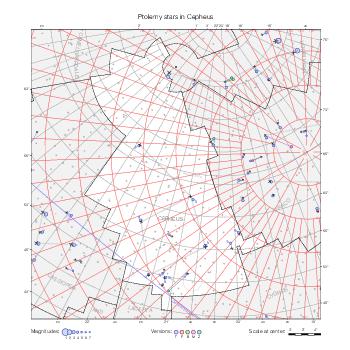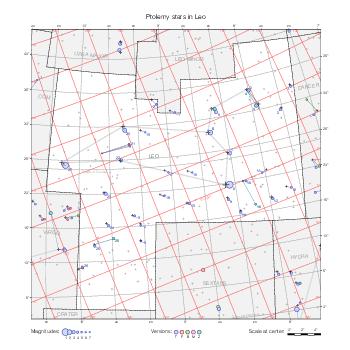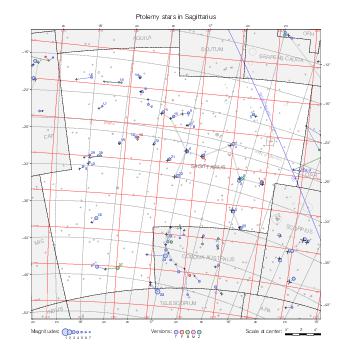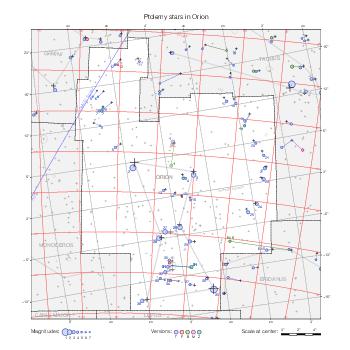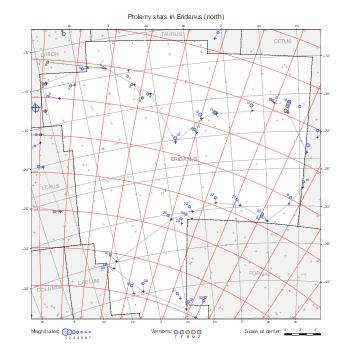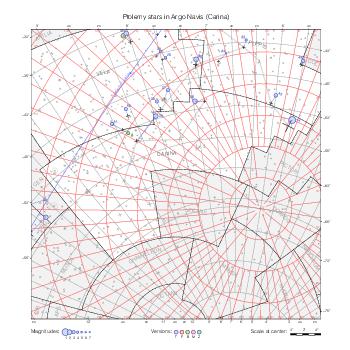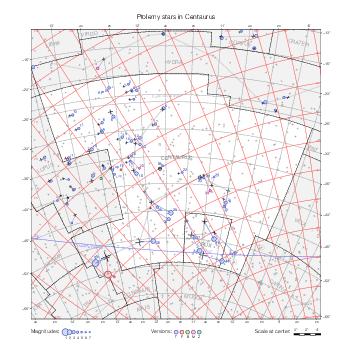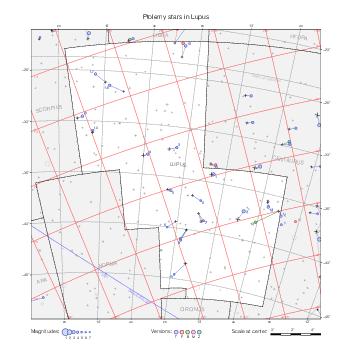Description
The star maps below represent the stars of Ptolemy's catalog, one constellation at a time, along with the corresponding stars according to modern catalogs. As explained on the catalog page, the available versions of Ptolemy's catalog offer different coordinates, magnitudes, and star associations for many stars. The maps represent the star positions according the main versions of Ptolemy's catalog mentioned on the catalog page, and the star identifications according to the file ident_o.dat described there (rather than each version's own identifications, which results in confusing maps). The legend on the maps associates colors with versions represented by letters according to the following table.
| Letter | Version |
|---|---|
| T | Toomer |
| P | Peters & Knobel |
| B | Baily |
| M | Manitius |
| Z | Flamsteed |
When multiple versions give the same coordinates, the colors follow the same order of precedence as that table. Differences in star magnitudes across versions are not represented. The maps do not include all the information included in the data files on the catalog page, but they give an idea of the precision of the catalog and the uncertainty that affects some of its parts, especially in the most southern constellations.
Following Verbunt & van Gent [1], I have assumed that the epoch of Hipparchus's observations is JD 1,674,573 (in the year 128 BCE) and the equinox of Ptolemy's coordinates JD 1,771,298 (in the year 137 CE). The maps represent stars in the ecliptic and equatorial coordinate systems corresponding to that equinox. The obliquity of the ecliptic was at that time close to 23°40'41" according to the IAU 2006 precession model, 23°51'20" according to the Almagest (Jones [2], Ashworth [4, note 12]). The maps use the IAU value.
Ptolemy's star are affected by a mean longitude error of about 1°. One explanation is that Ptolemy took Hipparchus's observations (even though he claims to have observed the catalog himself) and applied the inaccurate precession rate of 1° per century to reduce them to his own epoch. Some scholars have attempted to defend Ptolemy's integrity and explain the longitude error by a flaw in his solar theory. The first explanation is now believed to be true, as discussed in Verbunt & van Gent [1] and Rawlins [3].
Consequently, following [1] again, I have obtained the star positions by substracting 2°40' from Ptolemy's longitudes to reduce them to Hipparchus's epoch, and precessed the result from Hipparchus's epoch to Ptolemy's equinox using modern formulas. The coordinates obtained this way differ from the original ones by 1° of longitude on average, compensating for Ptolemy's error, and result in a better match with modern positions. The maps use the corrected coordinates.
The maps represent Ptolemy's stars as colored disks with a solid border and his nebulous objects as colored disks with a dotted border and a size corresponding to magnitude 3. They also represent reference stars as + crosses (the same star set as on these reference maps) at their positions taken from the Hipparcos catalog, adjusted to Hipparchus's epoch according to their proper motion, and precessed to Ptolemy's equinox. Each Ptolemy star is linked by a straight line segment to its modern equivalent(s) according to ident_o.dat.
Ptolemy stars are labeled with their number in their constellation. The label omits the constellation abbreviation when the star belongs to the constellation covered by the map, drawn with a white background. I use a tilde (~) character before the number or between the constellation abbreviation and the number to denote informes stars.
The modern constellation boundaries precessed to Ptolemy's equinox are also represented: an anachronism for sure, but it helps situate things. The maps are framed around the modern constellation boundaries exactly like the reference maps. The comparison reveals the modern names of Ptolemy's stars, shows the effect of the precession of the equinoxes on the coordinate systems after almost two millennia (for instance, compare the positions of the north pole on the Ursa Minor maps), and the displacement of high proper motion stars over this length of time (61 Cyg, μ Cas, α Cen, α Boo (Arcturus) are dramatic examples).
On the whole, the modern boundaries enclose their Ptolemy stars fairly well. Some of the modern constellations have annexed informes stars from Ptolemy's constellations. For instance,
- Canes Venatici, Leo Minor and Lynx, introduced by Hevelius, contain informes stars from Ursa Major,
- Coma Berenices, introduced by Caspar Vopel, has informes stars from Leo,
- Columba, introduced by Plancius, has informes stars from Canis Major,
- Microscopium, introduced by Lacaille, has informes stars from Piscis Austrinus.
Some of the ancient constellations have been modified, notably by Lacaille in the southern hemisphere. For instance,
- the stars of Argo Navis now belong to Lacaille's Puppis, Carina, Vela, and Pyxis,
- Crux, introduced by de Houtman, has been carved out of Centaurus.
Maps
The maps are enumerated in the same order as the constellations in Ptolemy's catalog. Larger constellations (Eridanus, Hydra, Argo Navis) and Serpens use more than one map. Maps covering Lynx, Coma Berenices, Columba, Monoceros, and Microscopium have been added even though they are not Ptolemaic constellations to ensure that every Ptolemy star is represented on at least one map.
References
[1] The star catalogues of Ptolemaios and Ulugh Beg by F. Verbunt and R. H. van Gent, Astronomy & Astrophysics, 455, A31 (2012).
[2] A. Jones, Eratosthenes, Hipparchus, and the obliquity of the ecliptic, Journal for the History of Astronomy, Vol. 33, Part 1, No. 110, pp. 15–19 (2002).
[3] Dennis Rawlins, An Investigation of the Ancient Star Catalog, Publications of the Astronomical Society of the Pacific, Vol. 94, p. 359, 1982.
[4] William B. Ashworth, Jr, Halley's Discovery of NGC 6231 and the Hazards of Early Star Nomenclature, Journal for the History of Astronomy, Vol. 12, pp. 1-10, 1981.







